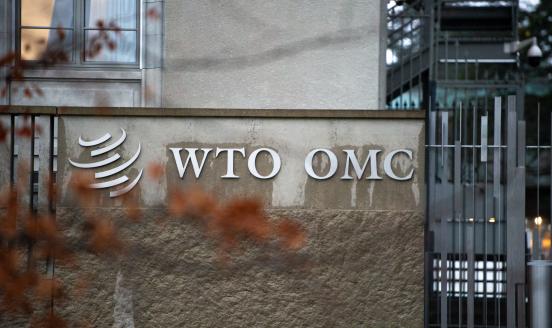What is in store for the EU’s trade relationship with the US ?
If faced with a resurgent President Trump after the next US election, the EU will have some difficult decisions to make as it is compelled to enter a

The drama surrounding the trade talks between China and the United States does not bode well for Europe’s efforts to defuse the crisis in its own relations with its most important ally and trading partner.
On April 15, the Council accorded the Commission negotiating authority to proceed on trade negotiations with the United States. This decision was reached despite the opposition of France, the Union’s second largest economy. It came hot on the heels of the European Parliament’s failure to provide direction to the negotiations, as a non-binding resolution on talks with Washington was defeated by a narrow margin.
Unfortunately, the EU-US negotiations are unlikely to succeed. Even so, Trump’s threat to impose auto tariffs if talks stall is unlikely to be carried out in the run-up to the U.S. elections in November 2020 and before the United States–Mexico–Canada Agreement (USMCA) is ratified by the US Congress. Should Trump be re-elected in November 2020, however, the threat of auto tariffs will become far more credible and the EU will have to face up to some tough decisions.
The EU-US negotiations aim to stabilise the world’s largest bilateral trade and investment relationship, but they are unlikely to succeed for three main reasons. First, the negotiating agendas of the two parties are extraordinarily far apart. Whereas, in line with Juncker’s deal with Trump last July, the Commission is preparing to negotiate solely on industrial products and an as-yet-unspecified ‘conformity’ agenda (how to reconcile disparate industrial standards), the negotiating objectives put to Congress by United States Trade Representative (USTR) Lighthizer is a 14-page document which includes 24 headings. These range from services, to government procurement and to currency manipulation – and, crucially, they include agriculture.
There is no escaping the fact that the negotiating agenda adopted by the USTR is entirely different than the one agreed by leaders in July. So, technically, the EU is not bound by that agreement to negotiate. More importantly it is very difficult to see how a deal that does not include agriculture – a sector where the US sees an offensive interest – but includes industrial goods – which the US sees as a defensive interest – can pass the US Senate, where farm states are powerfully represented. Insofar as the EU-US agreement is a treaty which requires changes to the US tariff schedule, it must pass the House of Representatives and be ratified in the Senate with a two-thirds majority.
Second, it is difficult for two parties, especially two giant economies with complex ratification procedures, to reach a deal for relatively small stakes. As became evident in various analyses done in preparation for the ill-fated Trans-Atlantic Trade and Investment Partnership Agreement (TTIP), the gains to be had from a narrow deal centred on tariffs on industrial products are minuscule, since tariffs are already very low at around 4%.[1] The gains from tariff reduction in industrial products are played up in the recent Commission analysis, which concludes that – when and if tariffs are driven down to zero – trade between the two parties will increase by between 8% and 9% by 2030, implying high combined price elasticity of demand and supply for traded products.
But even if one accepts this projection at face value, the effect on the two blocs’ GDP would be almost imperceptible. There is likely to be some displacement of trade with competitive third parties (trade diversion), which will reduce welfare. Still, the agreement is likely to yield tiny net welfare gains that result from a small improvement of efficiency and from lower prices for consumers in some sectors. The effect on aggregate demand would be near zero, as shifts in imports and exports would offset one another. The gains from the conformity agenda are, as always, difficult to assess, but the TTIP negotiations showed how thorny these exchanges can be, even in a context where the negotiating agenda was very broad and there were many more opportunities for trade-offs.
Third, as in the China case, the topmost objective put forward in the USTR’s negotiating objective is a reduction of the US bilateral deficit with the EU. This implies that any deal must be one-sided, with the US committing to little or no new trade liberalisation, leaving the EU to make the big changes.
As is evidently the case for China, this will be difficult for the EU to swallow. Moreover, even if the EU’s negotiators wanted to deliver on the US demand that its bilateral surplus with the US must decline, it is largely outside their power to do so. A major shift in macroeconomic and structural policies in the EU’s largest economies would be required to reduce the bloc’s large current-account surplus with the rest of the world. Even then, it is unclear the extent to which the new demand created would benefit the United States instead of, say, China, Korea and Japan, or other EU members.
To complicate matters, the EU takes the view that the commercial relations between the two parties are roughly in balance, since looking narrowly at Europe’s surplus with the United States on goods and services fails to consider investment income, which flows predominantly from the EU towards US corporations and investors. There is some economic basis to the EU argument, but the political reality is that US foreign investment in the EU – and elsewhere – is precisely what the Trump administration dislikes and is trying to discourage. Trump’s oft-stated objective is to bring back manufacturing to the United States.
The Commission’s negotiators, who are some of the world’s best prepared, are surely aware of these obstacles. But they and, above all, their political masters fear auto tariffs, which would be a calamity for European vehicle and parts manufacturers, especially those in Germany.
Yet, it would be extremely unwise for Trump to impose auto tariffs in the run-up to the presidential elections of November 2020. The president has delegated authority to Congress to impose such tariffs, following a finding by the Department of Commerce that auto imports (including those from allies) represent a threat to national security. Auto tariffs are widely opposed in Congress and by virtually all major constituencies, with the partial exception of some labour unions. To date, Trump has been careful to ensure that his tariff hikes (on China, aluminium and steel, etc.) affect producers but are largely imperceptible to consumers. True, tariffs have been imposed on washing machines and solar panels and these have hurt US consumers directly. But these are relatively small budget items. In contrast, a study by the Center for Automotive Research (CAR) concludes that 25% tariffs on automobiles and parts applied on all imports except those from Canada, Mexico and South Korea would add $2,750 to the price of the average car, reduce US vehicle sales by 1.3m units, and cause job losses in the hundreds of thousands over the next two or three years.
The job losses are due to a) the reduction in car sales, which affects the dealer, distribution and after-market service sector as well as US and foreign producers; b) the higher cost of imported parts, which makes the US car industry less competitive; c) the disruption of value chains and the mismatch between available capacity and consumer demand. An IHS Markit study broadly confirms the CAR estimates. The 20 or so Democratic presidential candidates must be praying silently that the president raises auto tariffs, preferably close to the election.
Moreover, Trump needs as much goodwill in Congress as he can muster for the USMCA to win ratification. In a recent column, Chuck Grassley, chairman of the Senate Finance Committee, stated that USMCA will not pass unless tariffs on steel and aluminium are lifted, because they have brought retaliation on American farm exports. Everyone understands that far more retaliatory measures, including a possible fully fledged trade war, will follow should auto tariffs be imposed. , but Trump is also playing for time. He is unlikely to support auto tariffs by the deadline May 18th, under current rules, and is instead likely to find ways to postpone the decision.
If Trump is not re-elected, I expect the next president, whether he or she is from the left or centre of the Democratic party, to continue to pursue a forceful trade agenda, especially with regard to China. However, even if it remains demanding of its partners, I would expect the US’ trade policy to become less adversarial and more predictable. In that scenario, whether the EU and the US will have sufficient appetite for another big trade negotiation after the sad experiences of recent years remains to be seen.
If, on the other hand, Trump is re-elected – which some believe is quite likely – his mercantilist, ‘America First’ agenda will have the wind in its sails. If Democrats win control of the Senate as well as the House, Trump will be hobbled on many fronts but not necessarily on trade. By the start of his second term, he may or may not have concluded one-sided deals with China and, quite possibly, with Japan. Unlike the EU, Japan is willing to negotiate on agriculture along the lines already previously agreed under the now-defunct Trans-Pacific Partnership (TPP). And Japan, which is utterly dependent on the US security umbrella in an increasingly difficult neighbourhood, may turn out to be a more pliable partner than in the past.
If faced with a resurgent Trump after November 2020, the EU will have some difficult decisions to make as it is compelled to enter a one-sided negotiation. Will it adopt the broad negotiating agenda demanded by Trump and Lighthizer? Will the EU negotiate on agriculture, a sector where it is the world’s largest exporter and yet bestows some of the world’s most generous subsidies? Is it willing to run the risk of tariffs on its most important export – automobiles – while Canadian, Korean, Mexican, and (perhaps) Japanese producers avail themselves of more favourable terms? Are the European surplus nations, such as Germany and the Netherlands, willing to change tack and adopt policies that stimulate domestic consumption and investment? Are Europeans willing to lower their high tariffs on cars, garments, shoes, and many other products?
Trade economists like myself can no doubt see a silver lining in these clouds, since Europeans should be embarking on these reforms anyway. The context is unappetising but ultimately the changes required of them by Trump’s demands may turn out to be in the interest of Europeans. If, however, there is no deal to be had, the future of the world’s largest trade relationship will be in peril. Under that scenario, two years from now the world trading system may be reeling from simultaneously raging EU-US and China-US trade disputes, further contributing to the progressive unravelling of the rules enshrined in the World Trade Organization.
[1] Tariff peaks (tariffs above 15%) are found in approximately 250 tariff lines in the US and 150 tariff lines in the EU



